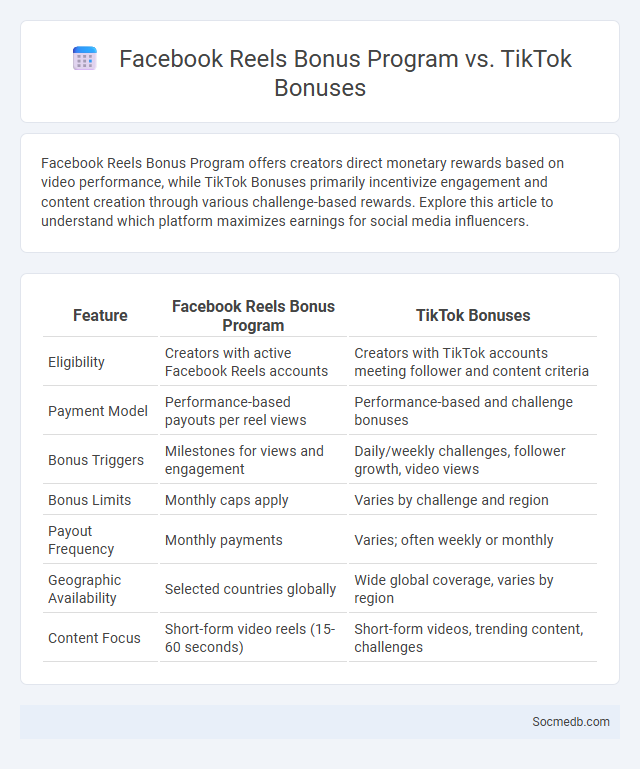
Photo illustration: Facebook Reels Bonus Program vs TikTok Bonuses
Facebook Reels Bonus Program offers creators direct monetary rewards based on video performance, while TikTok Bonuses primarily incentivize engagement and content creation through various challenge-based rewards. Explore this article to understand which platform maximizes earnings for social media influencers.
Table of Comparison
| Feature | Facebook Reels Bonus Program | TikTok Bonuses |
|---|---|---|
| Eligibility | Creators with active Facebook Reels accounts | Creators with TikTok accounts meeting follower and content criteria |
| Payment Model | Performance-based payouts per reel views | Performance-based and challenge bonuses |
| Bonus Triggers | Milestones for views and engagement | Daily/weekly challenges, follower growth, video views |
| Bonus Limits | Monthly caps apply | Varies by challenge and region |
| Payout Frequency | Monthly payments | Varies; often weekly or monthly |
| Geographic Availability | Selected countries globally | Wide global coverage, varies by region |
| Content Focus | Short-form video reels (15-60 seconds) | Short-form videos, trending content, challenges |
Overview of Facebook Reels Bonus Program
The Facebook Reels Bonus Program offers content creators a lucrative opportunity to monetize short-form videos posted on Facebook Reels. Participants can earn bonuses based on the number of views and engagement their reels receive, incentivizing consistent and high-quality content creation. This program enhances creator monetization options within the Meta ecosystem, competing directly with similar features on platforms like Instagram and TikTok.
Key Features of TikTok Bonuses
TikTok bonuses feature a range of key benefits, including performance-based rewards for content creators, live-stream gifting opportunities, and referral incentives that encourage platform growth. The platform utilizes an algorithm-driven reward system that boosts user engagement by distributing bonuses based on views, shares, and follower milestones. These incentives enhance creator motivation, contributing to a dynamic and interactive social media environment.
Monetization Models: Facebook vs TikTok
Facebook primarily monetizes through targeted advertising leveraging its extensive user data, offering businesses detailed demographic and behavioral insights to optimize ad performance. TikTok's monetization model emphasizes in-app purchases, including virtual gifts during live streams, alongside advertising options like branded content and native ads tailored for its predominantly younger audience. Both platforms use advanced algorithms to enhance ad relevance and user engagement, driving higher revenue through personalized content delivery.
Eligibility Requirements for Creators
Eligibility requirements for social media creators typically include a minimum age of 13 years and adherence to platform-specific community guidelines. Your account may need to meet follower thresholds or engagement rates to access monetization features or creator tools. Verification of identity and consistent content creation aligned with platform policies further qualifies you as an eligible social media creator.
Earnings Potential Comparison
Social media platforms offer varied earnings potential based on user engagement, follower count, and content niche, with influencers on Instagram and TikTok often commanding higher brand deals compared to YouTube creators who profit primarily through ad revenue. Your earnings can significantly increase by diversifying income streams through sponsored posts, affiliate marketing, and merchandise sales. Data from recent studies show that micro-influencers with 10,000 to 50,000 followers can earn up to $500 per post, while top-tier creators make six-figure incomes monthly.
Payout Processes and Timelines
Payout processes in social media platforms typically involve verifying your account and meeting minimum earning thresholds before disbursing funds. Timelines for receiving payments often range from 15 to 45 days after the end of a payment period, depending on the platform's policies and your chosen payment method. Ensuring your payout information is accurate and up to date helps avoid delays in your earnings reaching your account.
Content Performance Metrics
Content performance metrics on social media encompass key indicators such as engagement rate, reach, impressions, and click-through rate (CTR), which collectively measure how effectively content resonates with the target audience. Analyzing metrics like video views, shares, and sentiment analysis provides detailed insights into content quality and audience preferences. Optimizing posts based on performance data drives higher user interaction, brand visibility, and conversion rates across platforms like Instagram, Facebook, Twitter, and LinkedIn.
Geographic Availability and Restrictions
Social media platforms vary significantly in geographic availability, with some services like Facebook, Instagram, and Twitter accessible globally, while others face region-specific restrictions or bans due to local regulations or internet censorship. Your ability to access certain social media features may be limited depending on your country, impacting communication, content sharing, and online networking. Understanding these geographic restrictions helps you navigate platform accessibility and optimize your social media engagement worldwide.
Pros and Cons of Each Program
Facebook offers extensive networking opportunities with over 2.9 billion active users, making it ideal for maintaining personal and professional connections, while privacy concerns and misinformation remain major drawbacks. Instagram excels in visual content sharing and influencer marketing, boosting brand engagement, but its algorithm can promote unrealistic beauty standards and cause addictive scrolling. Twitter allows real-time news updates and public discourse, enhancing information dissemination, yet it faces criticism for harassment issues and the rapid spread of false information.
Choosing the Best Platform for Monetization
Choosing the best social media platform for monetization depends on your target audience, content type, and engagement style. Instagram excels for visual brands and influencers, TikTok offers rapid growth potential for creative video content, and YouTube provides robust monetization through ads and memberships. Understand your niche and analytics to optimize your revenue stream effectively.
 socmedb.com
socmedb.com